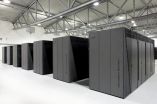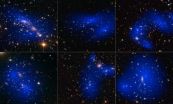Science: Theory of the strong interaction verified
Supercomputer calculates mass difference between neutron
2015-03-26
(Press-News.org) The fact that the neutron is slightly more massive than the proton is the reason why atomic nuclei have exactly those properties that make our world and ultimately our existence possible. Eighty years after the discovery of the neutron, a team of physicists from France, Germany, and Hungary headed by Zoltán Fodor, a researcher from Wuppertal, has finally calculated the tiny neutron-proton mass difference. The findings, which have been published in the current edition of Science, are considered a milestone by many physicists and confirm the theory of the strong interaction. As one of the most powerful computers in the world, JUQUEEN at Forschungszentrum Jülich was decisive for the simulation.
The existence and stability of atoms relies heavily on the fact that neutrons are slightly more mas-sive than protons. The experimentally determined masses differ by only around 0.14 percent. A slightly smaller or larger value of the mass difference would have led to a dramatically different universe, with too many neutrons, not enough hydrogen, or too few heavier elements. The tiny mass difference is the reason why free neutrons decay on average after around ten minutes, while protons - the unchanging building blocks of matter - remain stable for a practically unlimited period.
In 1972, about 40 years after the discovery of the neutron by Chadwick in 1932, Harald Fritzsch (Germany), Murray Gell-Mann (USA), and Heinrich Leutwyler (Switzerland) presented a consistent theory of particles and forces that form the neutron and the proton known as quantum chromodynamics. Today, we know that protons and neutrons are composed of "up quarks" and "down quarks". The proton is made of one down and two up quarks, while the neutron is composed of one up and two down quarks.
Simulations on supercomputers over the last few years confirmed that most of the mass of the proton and neutron results from the energy carried by their quark constituents in accordance with Einstein's formula E=mc2. However, a small contribution from the electromagnetic field surrounding the electrically charged proton should make it about 0.1 percent more massive than the neutral neutron. The fact that the neutron mass is measured to be larger is evidently due to the different masses of the quarks, as Fodor and his team have now shown in extremely complex simulations.
For the calculations, the team developed a new class of simulation techniques combining the laws of quantum chromodynamics with those of quantum electrodynamics in order to precisely deter-mine the effects of electromagnetic interactions. By controlling all error sources, the scientists suc-cessfully demonstrated how finely tuned the forces of nature are.
Professor Kurt Binder is Chairman of the Scientific Council of the John von Neumann Institute for Computing (NIC) and member of the German Gauss Centre for Supercomputing. Both organizations allocate computation time on JUQUEEN to users in a competitive process. "Only using world-class computers, such as those available to the science community at Forschungszentrum Jülich, was it possible to achieve this milestone in computer simulation," says Binder. JUQUEEN was supported in the process by its "colleagues" operated by the French science organizations CNRS and GENCI as well as by the computing centres in Garching (LRZ) and Stuttgart (HLRS).
The results of this work by Fodor's team of physicists from Bergische Universität Wuppertal, Centre de Physique Théorique de Marseille, Eötvös University Budapest, and Forschungszentrum Jülich open the door to a new generation of simulations that will be used to determine the properties of quarks, gluons, and nuclear particles. According to Professor Kálmán Szabó from Forschungszentrum Jülich, "In future, we will be able to test the standard model of elementary particle physics with a tenfold increase in precision, which could possibly enable us to identify effects that would help us to uncover new physics beyond the standard model."
"Forschungszentrum Jülich is supporting the work of excellent researchers in many areas of science with its supercomputers. Basic research such as elementary particle physics is an area where methods are forged, and the resulting tools are also welcomed by several other users," says Prof. Dr. Sebastian M. Schmidt, member of the Board of Directors at Jülich who has supported and encouraged these scientific activities for years.
INFORMATION:
[Attachments] See images for this press release:

ELSE PRESS RELEASES FROM THIS DATE:
2015-03-26
Astronomers using observations from the NASA/ESA Hubble Space Telescope and NASA's Chandra X-ray Observatory have studied how dark matter in clusters of galaxies behaves when the clusters collide. The results, published in the journal Science on 27 March 2015, show that dark matter interacts with itself even less than previously thought, and narrows down the options for what this mysterious substance might be.
Dark matter is a giant question mark looming over our knowledge of the Universe. There is more dark matter in the Universe than visible matter, but it is extremely ...
2015-03-26
Say you're out shopping for basic household goods -- perhaps orange juice and soup. Or light bulbs. Or diapers for your young child. How do you choose the products you buy? Is it a complicated decision, or a simple one?
It could be complex: Factors like price, quality, and brand loyalty may run through your mind. Indeed, some scholars have developed complicated models of consumer decision-making, in which people accumulate substantial product knowledge, then weigh that knowledge against the opportunity to explore less-known products.
But in a new paper, MIT researchers ...
2015-03-26
(WASHINGTON - March, 26, 2015) - A committee of lymphoma experts today unveiled a strategic roadmap identifying key priority areas in both infrastructure and research that will be critical for advancing treatments for people with lymphoma. The report is meant to inform future research directions as well as funding decisions by strategic partners that could include government agencies and the private sector. The strategic recommendations were developed after a review of the state of the science in lymphoma conducted at a special ASH Meeting on Lymphoma Biology held in August ...
2015-03-26
EAST LANSING, Mich. -- It may sound like the makings of a joke, but answering the question of how chickens crossed the sea may soon provide more than just a punch line.
Michigan State University researcher Eben Gering has collaborated with a team in a study of the mysterious ancestry of the feral chicken population that has overrun the Hawaiian Island of Kauai. Their results, published in the current issue of Molecular Ecology, may aid efforts to curtail the damage of invasive species in the future, and help improve the biosecurity of domestic chicken breeds.
Domesticated ...
2015-03-26
Washington, DC (March 26, 2015)--As the world looks to American innovation to fight Ebola, malaria, tuberculosis, and a host of other health threats, a new report released today on Capitol Hill warns budget battles in Washington are eroding preparedness at home and abroad at a time when scientific advances are poised to deliver new lifesaving drugs, vaccines, and diagnostics.
"Since 2009, we've seen declining, or at best stagnating, support for global health research and development, with politics trumping prudent investments that could protect the US and the world from ...
2015-03-26
The expansion of no-take marine reserves (NTMRs) within Australia's Great Barrier Reef Marine Park more than a decade ago is working to protect fish just as experts had hoped it would, say researchers who have been monitoring the reef via underwater surveys. The findings, reported in the Cell Press journal Current Biology on March 26, come as encouraging news for Australia's largest reef and for other, similar projects around the world.
While the park reserves could not protect the reef directly from extensive physical damage caused by Tropical Cyclone Hamish in 2009, ...
2015-03-26
CHAMPAIGN, Ill. -- Using high-performance computing and genetic engineering to boost the photosynthetic efficiency of plants offers the best hope of increasing crop yields enough to feed a planet expected to have 9.5 billion people on it by 2050, researchers report in the journal Cell.
There has never been a better time to try this, said University of Illinois plant biology professor Stephen P. Long, who wrote the report with colleagues from Illinois and the CAS-MPG Partner Institute of Computational Biology in Shanghai.
"We now know every step in the processes that ...
2015-03-26
Scientists have revealed a brand new function for one of the first cancer genes ever discovered - the retinoblastoma gene - in a finding that could open up exciting new approaches to treatment.
The retinoblastoma gene is so called because mutations to it cause a rare children's eye cancer of the same name, and is known to play a central role in stopping healthy cells from dividing uncontrollably.
Now the new study - jointly led by scientists at The Institute of Cancer Research, London, and UCL (University College London) - has found that the gene also has another important ...
2015-03-26
How you feel pain is affected by where sources of pain are in relation to each other, and so crossing your fingers can change what you feel on a single finger, finds new UCL research.
The research, published in Current Biology, used a variation on an established pain experiment, known as the "thermal grill illusion". In the thermal grill illusion, a pattern of warm-cold-warm temperatures applied to the index, middle and ring finger respectively causes a paradoxical, sometimes painful, sensation of burning heat on the middle finger - even though this finger is actually ...
2015-03-26
Sand, rocks, grains, salt or sugar are what physicists call granular media. A better understanding of granular media is important - particularly when mixed with water and air, as it forms the foundations of houses and off-shore windmills. Until recently, there was no single theory that could account for granular media's flows at different speeds. Now, a new theory dubbed GSH, which stands for granular solid hydrodynamics, is supplementing previous models of granular material that work only for narrow speed ranges. And Yimin Jiang from Central South University, Changsha, ...
LAST 30 PRESS RELEASES:
[Press-News.org] Science: Theory of the strong interaction verified
Supercomputer calculates mass difference between neutron




